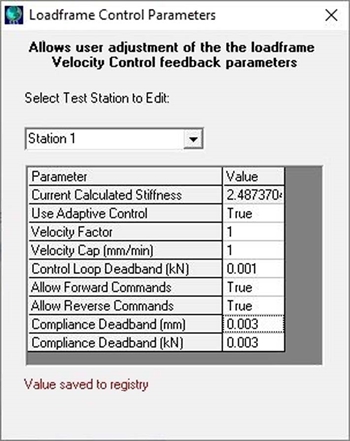GDS have implemented a new “TraditionalCell Loadframe Control Parameter Tool” in GDSLab, to enhance control when performing stress based tests (with a traditional loadframe) using velocity feedback control. When launched from the GDSLab menu bar (see image below), the tool allows the user to manage certain parameters within the control feedback loop to improve the stability and accuracy of control, this functionality includes adaptive control*.

If a user sets adaptive control to true, then the velocity sent to the loadframe will be factored according to the current calculated stiffness value, which is calculated from the current behaviour of the sample. A sample stiffness value of 1kN/mm will result in the same relationship as if adaptive control were not being used. If the calculated stiffness value is greater than 1kN/mm then the adaptive control will reduce the velocity to make control softer to avoid oscillation on a stiffer test specimen. If the calculated stiffness value is less than 1kN/mm then the adaptive control will increase the velocity to make control more quickly reach the target on a softer test specimen.
The TraditionalCell Loadframe Control Parameter Tool works with all GDS loadframes and 3rd party frames which are using GDSLab to target a Stress via velocity control (i.e. using TraditionalCell). Any GDS load frame with an optional Loadcell RFM fitted would not be set up to use this tool due to the RFM allowing the Loadframe to target load directly within the loadframe firmware, which is preferable.
The software update is free to all customers with GDSLab, you just need to ensure you have the latest copy of software which can be found
here. If you interested in purchasing GDSLab, please contact one of our sales team at
sales@gdsinstruments.com
*Please Note: Adaptive Control is only applicable if your ini file calls for the TraditionalCell cell type.